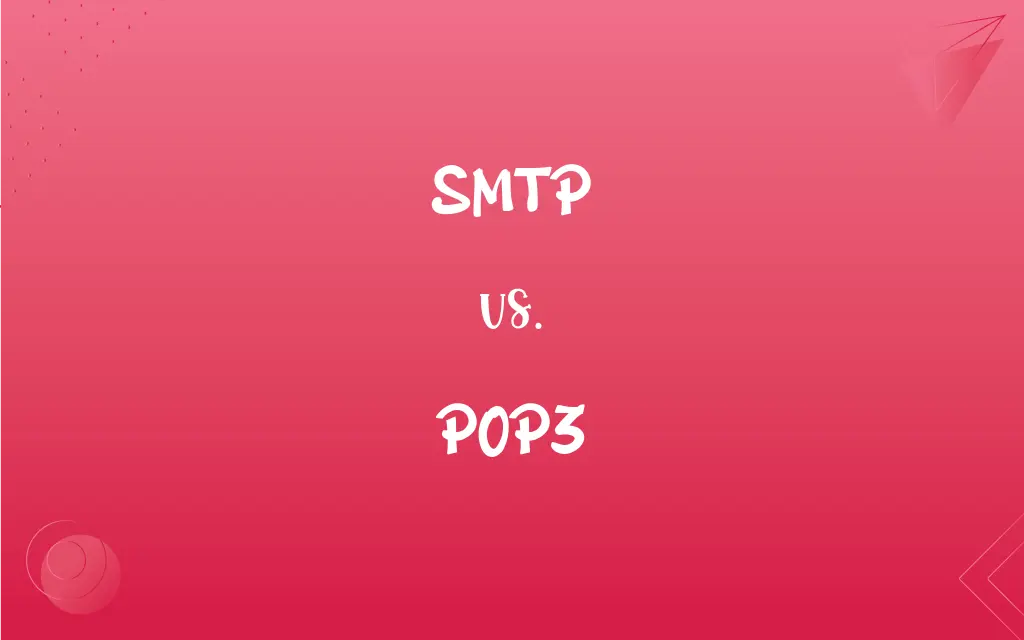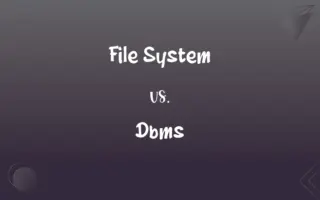SMTP vs. POP3: What's the Difference?
Edited by Janet White || By Harlon Moss || Updated on October 26, 2023
SMTP (Simple Mail Transfer Protocol) sends emails, while POP3 (Post Office Protocol 3) retrieves and stores emails from a mail server.

Key Differences
SMTP, or Simple Mail Transfer Protocol, is primarily used for sending emails between servers and clients. On the other hand, POP3, which stands for Post Office Protocol version 3, is designed to retrieve emails from a server and store them locally on a client's device.
In the realm of electronic mail, SMTP plays a crucial role by ensuring that emails sent from one user reach the intended recipient's email server. Conversely, when a user wishes to download these messages onto their device, they'd rely on a protocol like POP3 to do so.
A significant difference between SMTP and POP3 is in their operations. SMTP is outbound, facilitating the process of sending out messages. In contrast, POP3 is inbound, handling the downloading and local storage of messages for users to access, even offline.
Functionally, SMTP is like a postman delivering mail to a mailbox, ensuring that messages reach their destination. Meanwhile, POP3 is the mechanism that allows users to open their mailbox and take their mail inside their house, storing it for later reading.
While both SMTP and POP3 are integral parts of the email ecosystem, they serve distinct functions. SMTP is all about transmission and delivery, while POP3 focuses on retrieval and local storage, ensuring users have access to their messages regardless of their online status.
ADVERTISEMENT
Comparison Chart
Primary Function
Sends emails
Retrieves and stores emails locally
Direction
Outbound
Inbound
Protocol Type
Transmission protocol
Retrieval protocol
Offline Access
Doesn't provide offline access to sent emails
Provides offline access to received emails
Storage Location
On servers
On the client's device
ADVERTISEMENT
SMTP and POP3 Definitions
SMTP
SMTP operates as the standard for sending mail over the Internet.
SMTP servers handle the heavy lifting of email delivery.
POP3
POP3 allows users to download emails to their local machine.
She prefers using POP3 because it lets her read emails offline.
SMTP
SMTP ensures email messages reach their intended destination server.
Without SMTP, our emails wouldn't get to where they need to go.
POP3
POP3 is a protocol that retrieves email from remote servers.
For her email client, she set it up with POP3 settings to fetch her messages.
SMTP
SMTP is a protocol for sending electronic mail.
When you hit send, SMTP ensures your email reaches the recipient.
POP3
POP3 is the third version of the Post Office Protocol for email retrieval.
After checking his emails, they're downloaded using POP3 and stored on his computer.
SMTP
SMTP governs the delivery of outgoing emails.
For her website's contact form, she set up an SMTP service.
POP3
POP3 downloads and deletes emails from the server, storing them locally.
Because of POP3, her emails are saved on her laptop, and no longer on the server.
SMTP
SMTP facilitates email transmission between servers.
The email server uses SMTP to relay messages to other servers.
POP3
POP3 provides offline access by storing emails on the client's device.
Once downloaded via POP3, he could access his emails without an Internet connection.
FAQs
What is the main function of SMTP?
SMTP's primary function is to send emails.
Is SMTP used for receiving emails?
No, SMTP is primarily for sending emails.
Does SMTP work with any email provider?
SMTP is a universal protocol, but specific settings might vary by provider.
Can emails be accessed offline with POP3?
Yes, once downloaded, POP3 allows offline email access.
How do POP3 and SMTP complement each other?
SMTP sends emails to a server, and POP3 retrieves them for local storage.
How does POP3 help email users?
POP3 retrieves emails from a server and stores them locally for offline access.
Is security a concern with SMTP and POP3?
Yes, secure versions (like SMTPS and POP3S) use encryption for added security.
Can one email use both SMTP and POP3?
Yes, SMTP can send an email, and POP3 can retrieve and store the same email later.
Can I switch from POP3 to IMAP?
Yes, but ensure your emails are backed up as switching can affect locally stored emails.
What does SMTP stand for?
SMTP stands for Simple Mail Transfer Protocol.
What does POP3 represent?
POP3 stands for Post Office Protocol version 3.
How do webmail services like Gmail use SMTP and POP3?
Services like Gmail use SMTP to send and allow users to configure POP3 or IMAP for email retrieval.
Where are emails stored with SMTP?
With SMTP, emails are stored on servers until delivered.
Which is better for mobile devices, POP3 or IMAP?
IMAP is generally preferred for mobile devices as it syncs emails across multiple devices.
Do email clients need SMTP settings?
Yes, to send emails, email clients require SMTP server settings.
Are there alternatives to POP3 for email retrieval?
Yes, IMAP (Internet Message Access Protocol) is another popular email retrieval protocol.
Is POP3 newer than SMTP?
No, both have been around for a long time, but POP3 is the third version of the Post Office Protocol.
What happens to emails on the server after being downloaded via POP3?
Typically, they are deleted, but settings can be adjusted to keep a copy.
Why don't we see emails being sent when using SMTP?
SMTP works in the background, ensuring seamless email transmission without user intervention.
Can you use SMTP without POP3?
Yes, you can send emails with SMTP without retrieving them using POP3.
About Author
Written by
Harlon MossHarlon is a seasoned quality moderator and accomplished content writer for Difference Wiki. An alumnus of the prestigious University of California, he earned his degree in Computer Science. Leveraging his academic background, Harlon brings a meticulous and informed perspective to his work, ensuring content accuracy and excellence.
Edited by
Janet WhiteJanet White has been an esteemed writer and blogger for Difference Wiki. Holding a Master's degree in Science and Medical Journalism from the prestigious Boston University, she has consistently demonstrated her expertise and passion for her field. When she's not immersed in her work, Janet relishes her time exercising, delving into a good book, and cherishing moments with friends and family.































































